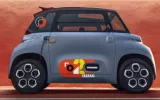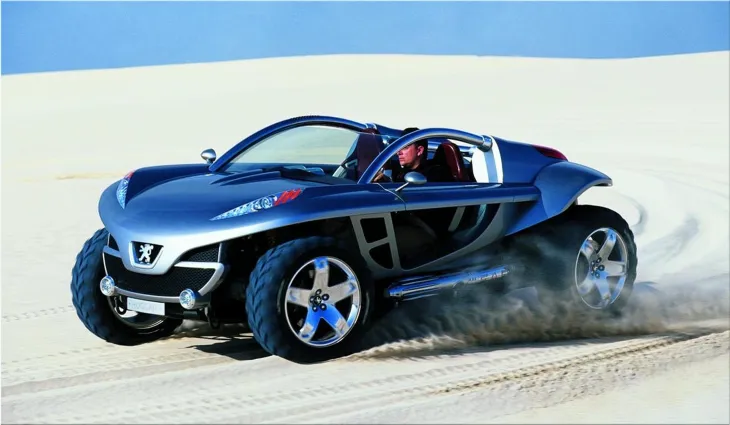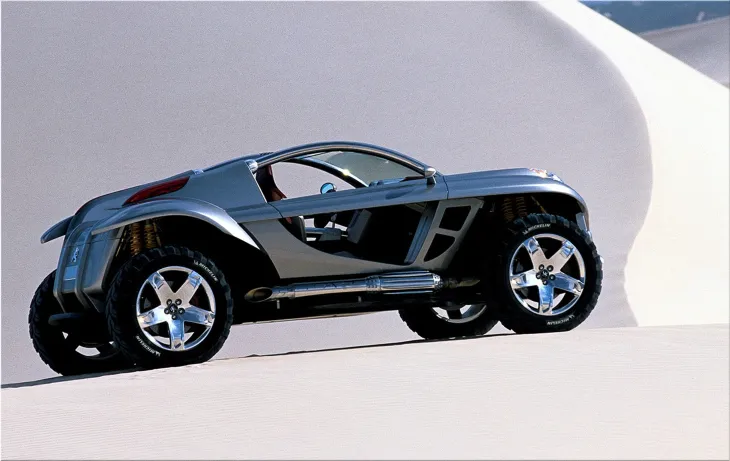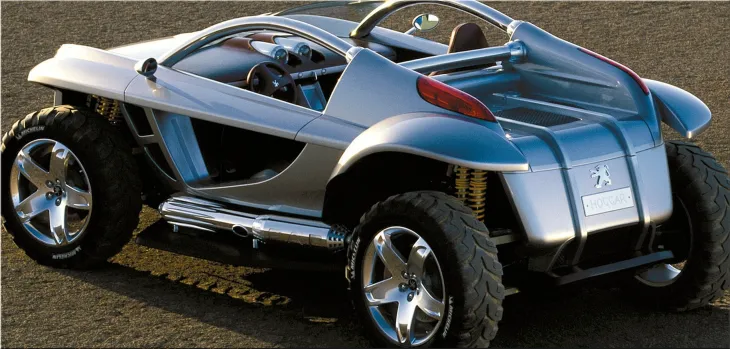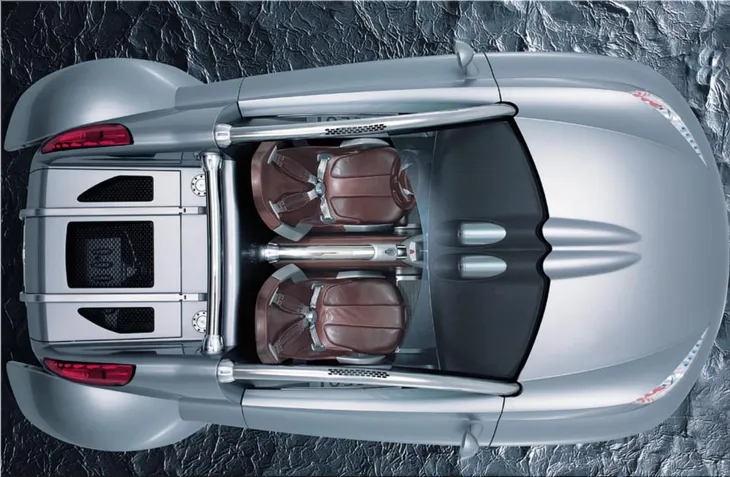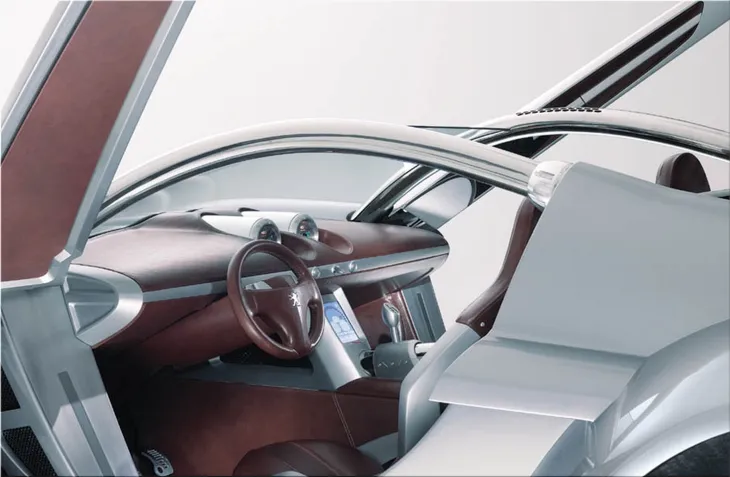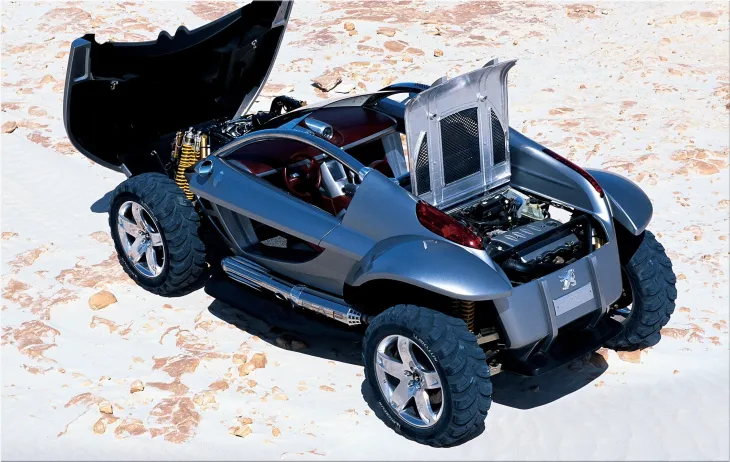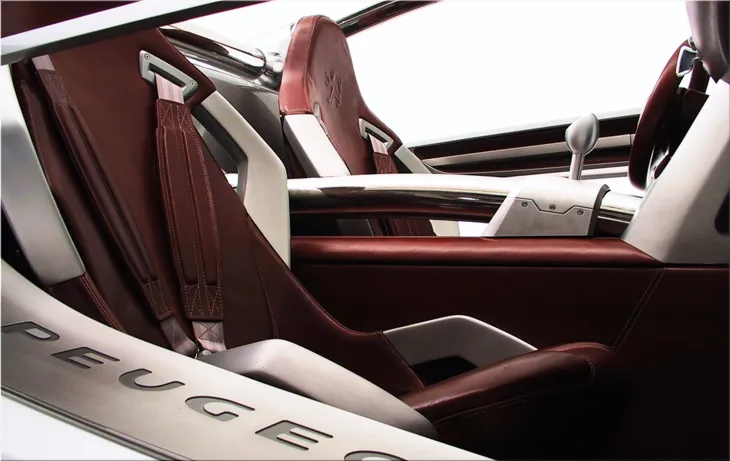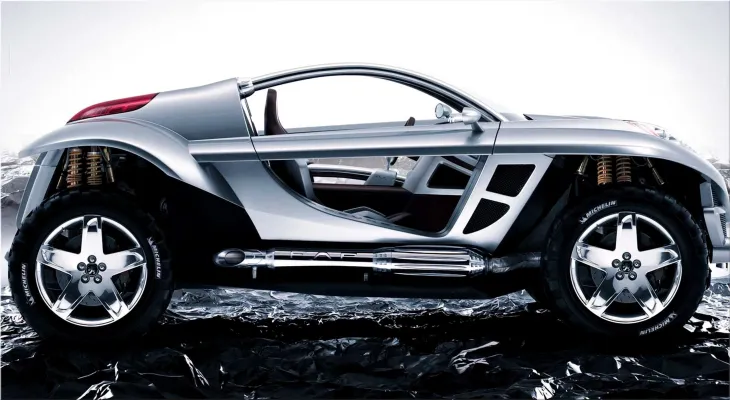Some concept cars are designed to turn heads at auto shows, and some look like they belong in a science fiction movie. Then there’s the Peugeot Hoggar, a 2003 concept vehicle that looked like it wanted to punch the desert in the face and steal its lunch money.
This wild, twin-engine, all-terrain beast wasn’t built to cruise boulevards or impress valet attendants. It was Peugeot’s way of reminding the world that they knew how to make machines that could eat sand dunes for breakfast. It also happened to be a love letter to Peugeot’s long history of dominating off-road rally racing, especially in the brutal Dakar Rally.
Peugeot’s Love Affair with the Desert (and How They Conquered It)
If you associate Peugeot with small city cars and baguette runs, you’re only seeing half the picture. The other half? A dust-covered rally monster tearing across the Sahara at speeds that make camels reconsider their career choices.
Peugeot’s desert racing résumé is filled with victories that could make a Hollywood underdog story look tame:
- 1987-1990 Dakar Rally Domination – Peugeot wasn’t just in the Dakar Rally; they owned it. The Peugeot 205 Turbo 16 won in 1987 and 1988, proving that a tiny hatchback could terrify the competition. Then Peugeot one-upped itself with the 405 Turbo 16, which kept the winning streak alive in 1989 and 1990.
- Pikes Peak 1988: The “Climb Dance” Victory – Ari Vatanen took a Peugeot 405 Turbo 16 up Pikes Peak, driving like a man possessed while barely touching the brakes. The result? A legendary win and a short film (“Climb Dance”) that’s still worshipped by petrolheads today.
With all this history, Peugeot clearly had an unhealthy addiction to going fast in places where people usually get lost. So when they unveiled the Hoggar, it wasn’t just for show—it was a desert warrior in disguise.
Design and Engineering: The Hoggar Was Built Like a Tank, But Faster
When Peugeot’s engineers sat down to design the Hoggar, their brainstorming session must have included phrases like:
✔ "Let’s put two engines in it.”
✔ "It should look like Mad Max designed it.”
✔ "How much suspension travel is too much? Answer: There’s no such thing.”
The result? A rugged, all-terrain dune crusher with some of the most over-the-top features ever stuffed into a Peugeot concept car:
- A Monocoque Body That Laughs at Crashes – The entire body was a single-piece carbon fiber honeycomb structure, making it light but tough enough to survive a roll or two (or three, depending on how ambitious you were).
- Twin Engines, Because One is for Amateurs – Most cars struggle to make use of one engine, but the Hoggar decided to run two. Each 2.2L HDi diesel engine powered one axle, creating a bizarre but effective all-wheel-drive setup that delivered 360 hp and 590 lb-ft of torque. That’s enough power to launch the Hoggar over sand dunes like a grasshopper on steroids.
- A Suspension That Could Handle an Earthquake – The Hoggar’s aluminum double-wishbone suspension was so advanced it could handle half a meter of vertical movement. This meant it could glide over rocks, potholes, and probably small countries without breaking a sweat.
Peugeot didn’t just build a car; they built a desert-crushing mutant that looked like it should come with a "DO NOT ATTEMPT" warning label.
Interior: Where Sci-Fi Met Sandstorms
Most concept cars focus on looking fancy inside. The Hoggar? It looked like a fighter jet cockpit had a baby with a dune buggy. Peugeot didn’t waste time on leather seats and mood lighting. Instead, they packed it with gadgets meant for serious desert warriors:
- Touchscreen Display (In 2003!) – Before Tesla made giant touchscreens cool, the Hoggar already had a central digital display for navigation and vehicle controls. In 2003, this was borderline futuristic.
- Dual Tachometers, Because Two Engines Deserve Two Gauges – Unlike normal cars, the Hoggar’s dashboard had two tachometers, one for each engine. It was Peugeot’s way of saying, “You’ve got double the power, so pay attention.”
This was not a car for casual drivers. If you needed a cupholder and a cozy ride, buy a 206. If you wanted to scare sand dunes into submission, the Hoggar was ready.
The Name "Hoggar" and Its Unexpected Comeback
You might think the Hoggar name was locked away in Peugeot’s secret vault after 2003, never to be seen again. Nope. It made a surprise comeback in 2010, but not as a desert-chomping concept. Instead, Peugeot turned it into a compact pickup truck for the Brazilian market.
This new Hoggar was based on the Peugeot 206+ and Peugeot Partner platforms, which meant it was practical but lacked the wild personality of its concept ancestor. It was Peugeot saying, "Okay, maybe two engines was too much. Here’s a small truck instead.”
Despite being tamer than the original, the 2010 Hoggar served a real purpose, offering a rugged and affordable pickup for South America. But for fans of the 2003 concept, it was like expecting a lion and getting a house cat instead.
Why the Hoggar Concept Still Matters
Even though the Hoggar never made it to production, it remains one of Peugeot’s boldest designs. Here’s why people still talk about it:
✔ It Was Ahead of Its Time – Two engines, a touchscreen, and a carbon-fiber body? In 2003? That’s decades ahead of most production cars.
✔ It Showed Peugeot’s Wild Side – Forget city hatchbacks. The Hoggar was proof that Peugeot had the guts to build something crazy and make it work.
✔ It Proved Peugeot Wasn’t Done with Off-Roading – Peugeot disappeared from Dakar for years, but when they returned in 2015 with the 2008 DKR, they won again. The Hoggar wasn’t just a concept; it was a preview of things to come.
Conclusion
The Peugeot Hoggar wasn’t a normal concept car. It was a mechanical mic drop, a wild experiment that put two engines in a carbon-fiber dune buggy just because Peugeot could. It never went into production, but it proved that Peugeot wasn’t afraid to take risks.
Would it have been practical? No. Would it have been street-legal? Unlikely. But would it have been the most fun you could ever have on four wheels? Absolutely.
And that’s why 20 years later, the Hoggar is still legendary.



